재고 관리 방법에 대한 51가지 전문가 팁:재고 관리 방법 선택, 데이터 수집 및 분석 팁, 건전한 재고 관리 정책 구현
재고 관리는 모든 산업 분야의 비즈니스에 중요한 기능입니다. 효과적인 재고 관리 방법이 없으면 공급망이 어려움을 겪고 고객의 요구를 적절하게 충족할 수 없으며 궁극적으로 회사의 수익에 이러한 부적절함이 반영됩니다.
그러나 재고 관리를 위한 올바른 방법을 선택하고 효과적인 정책을 개발해야 합니다. 프로세스를 따르고 재고 관리 방법의 정확성을 개선하고 정확한 데이터를 수집하여 비즈니스의 다른 영역에 정보를 제공하는 방법을 이해하기 위해 정확한 데이터를 수집하는 것은 간단하고 포괄적인 솔루션이 없는 문제입니다.
이 때문에 회사의 현재 비즈니스 시나리오를 평가하여 핵심 요구 사항을 식별하고 이러한 고유한 요구 사항을 가장 잘 수용할 수 있는 시스템을 선택하고 프로세스를 개발하는 것이 종종 처음으로 재고 관리 시스템을 선택하는 기업에게 필요한 첫 번째 단계입니다. 또한 기업이 조직 내에서 발생한 성장이나 변화를 고려하여 현재 시스템과 프로세스가 적절한지 확인하기 위해 이러한 감사를 주기적으로 수행하는 것도 좋은 생각입니다.
기업이 비즈니스에 적합한 방법론을 선택하거나 개발할 수 있도록 지원하기 위해 요구 사항에 따라 올바른 재고 관리 프레임워크 또는 방법론을 선택하는 데 도움이 되는 정보에서 회사의 고유한 비즈니스 요구 사항을 이해하고 효과적인 재고 관리 정책을 생성 및 시행하는 데 도움이 되는 정보에 이르기까지 재고 관리 방법에 대한 51가지 전문가 팁 목록을 작성했습니다. 특정 섹션에서 도움말을 찾아보려면 아래 링크를 사용하여 각 카테고리로 이동하세요.
바로가기:
- 적절한 재고 관리 방법 선택
- 재고 관리 기본 사항
- 효과적인 인벤토리 관리를 위한 데이터 수집 및 분석 팁
- 재고 및 회사의 요구 사항 파악
- 효과적인 재고 관리 정책 수립
적절한 인벤토리 관리 방법 선택
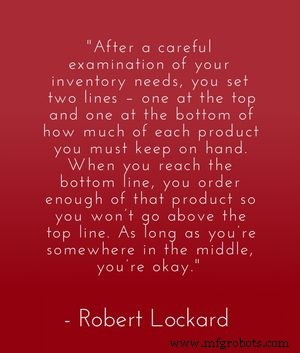
1. 최소-최대 재고 관리 방법은 특정 품목에 대해 유지해야 하는 재고의 양을 정의하는 데 도움이 됩니다. “재고 요구 사항을 주의 깊게 조사한 후, 두 줄을 설정합니다. 하나는 상단에, 다른 하나는 하단에 각 제품의 수중에 보관해야 하는 양입니다. 최종선에 도달하면 해당 제품을 충분히 주문하여 최고선 이상으로 올라가지 않습니다. 중간 어딘가에 있으면 괜찮습니다.
“장점:이 방법이 간단하고 인벤토리 균형 작업을 매우 간단하게 만듭니다.
“단점:단순하기 때문에 너무 많은 제품을 주문하거나 도착하기 전에 품절될 수 있기 때문에 문제가 발생합니다." – Robert Lockard, 당신이 알아야 할 4가지 재고 관리 방법 , 인벤토리 시스템 소프트웨어; 트위터:@Fishbowl
2. ABC 방법은 일부 산업에서 가장 일반적으로 사용되는 재고 관리 방법 중 하나입니다. “이것은 소매 산업 전반에 걸쳐 사용되는 일반적인 방법 중 하나이며 때로는 재고를 더 잘 제어하기 위해 다른 방법과 결합됩니다. 이것은 판매 기여도와 구색 계획에서 중요도에 따라 제품을 분류하는 재고 분류 기술에 가깝습니다.
“A- 카테고리 제품은 판매 및 마진이 높은 주력 제품의 최대 식료품 점입니다. . 일반적으로 전체 매출의 80%를 차지하는 구색의 상위 20% 제품은 매출 손실이 없도록 엄격한 재고 관리가 필요한 A 카테고리로 분류됩니다. 매출의 80%에 기여하는 제품의 20%는 80-20 법칙 또는 파레토 원칙으로 알려져 있습니다.
“C-Category 제품은 매출 기여도가 낮은 최하위 제품입니다. 이러한 품목은 비즈니스에 거의 중요하지 않으며 고객 요구 사항의 유일한 목적으로만 보관됩니다.
“B-Category 제품은 소매업체에 중요하지만 A Category 제품에 비해 덜 중요합니다.” – Suresh Ram, 재고 관리 시스템 유형 , 소매에 대해 자세히 논의하기
3. 공급업체 재고 관리는 일부 산업의 옵션입니다. “이름에서 알 수 있듯이 VMI(Vendor-Managed Inventory)는 공급업체(공급업체)가 관리하는 재고입니다. 그리고 이것보다 더 많은 것이 있을 수 있지만 최소한 이것은 공급업체가 보충 시기와 보충 양을 결정한다는 것을 의미합니다.
“공급업체 관리 재고는 새로운 것이 아닙니다. 사실 그것은 오랫동안 존재해 왔으며 당신이 생각하는 것보다 훨씬 더 일반적입니다. 식당에서 일한 적이 있다면 "제빵사"가 매일 나타나는 것을 보았을 것입니다. 재고를 확인하고(빵, 빵 등을 직접 확인) 그의 트럭에 가서 물건을 사십시오. . 이발소에서 이발사(예, 저는 구식입니다. 저는 이발소에 갑니다)가 판매하거나 사용하는 많은 헤어 제품도 공급업체에서 관리합니다. 이 경우 실제로 재고를 "관리"하는 것은 해당 제품의 영업 담당자일 것입니다. 그는 자신의 차 트렁크에서 이발소를 재입고할 수 있습니다. 오래된 독립 철물점에서는 너트, 볼트, 와셔, O-링 등과 같은 품목을 공급업체에서 관리하는 경우가 많았습니다. 대기업에서는 배송 상자, 사무용품 또는 청소/유지보수 용품을 공급업체에서 관리할 수 있습니다.” – Dave Piasecki, VMI(Vendor-Managed Inventory):정의 및 사용 시기 , InventoryOps.com
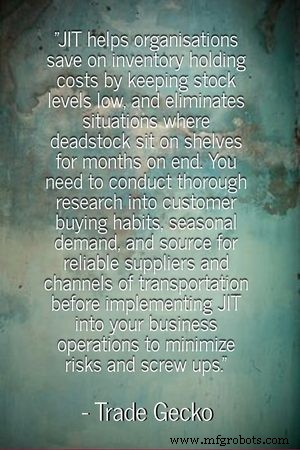
4. Just In Time 재고 관리 방법은 위험한 관행으로 간주되지만 기업이 보유하고 있는 재고의 양을 줄여 간접비를 줄일 수 있습니다. “JIT(Just In Time) 방식은 기업이 보유하고 있는 재고량을 줄이는 데 효과적입니다. 유통 또는 판매에 필요한 며칠 전에만 재고를 구매하여 사용 시간에 맞춰 상품이 도착할 수 있도록 하기 때문에 위험한 기술로 간주됩니다.
“JIT는 조직이 재고 수준을 유지하여 재고 유지 비용을 절약할 수 있도록 도와줍니다. 낮고 재고가 몇 달 동안 선반에 놓여 있는 상황을 제거합니다. 위험과 문제를 최소화하기 위해 비즈니스 운영에 JIT를 구현하기 전에 신뢰할 수 있는 공급업체 및 운송 경로에 대한 고객 구매 습관, 계절적 수요, 출처에 대한 철저한 조사를 수행해야 합니다." – 재고 관리 기술 , 무역 게코; 트위터:@tradegeco
5. 다기간 재고 방법에는 고정 주문 수량과 고정 기간 주문이라는 두 가지 주요 변형이 있습니다. “다기간 인벤토리 모델에는 두 가지 변형이 있을 수 있습니다. 고정 주문 수량 시스템은 주문이 이루어질 때마다 고정된 금액으로 주문이 이루어지는 시스템입니다. 주문은 최소 재고 수준에 도달하는 것과 같은 이벤트가 발생할 때 수행됩니다. 두 번째 변형은 재고 수준에 대한 월별 검토가 있는 경우와 같이 특정 시간에 주문이 이루어지는 고정 기간 모델입니다. 주문량은 필요한 재고량에 따라 달라집니다.
“이 모델의 주요 차이점은 고정 주문량 모델에서는 재고 수준이 낮을 때 주문이 이루어지도록 지속적으로 모니터링해야 한다는 것입니다. 적절한 수준으로 감소합니다. 고정 기간 모델의 재고 수준은 주문이 예정된 시간에만 확인됩니다. 고정 주문 수량 모델에서 재고 수준은 일반적으로 더 높으며 이 시스템은 더 비싸고 중요한 품목에 사용되는 경향이 있습니다. 또한 재고 모델을 지속적으로 측정해야 하기 때문에 유지 관리에 더 많은 시간이 필요합니다.
“고정 주문 수량 모델은 제품 수요가 일정하고 제품 리드 타임이 알려져 있고 신뢰할 수 있으며 가격이 변하지 않는 매우 안정적인 상황에서 사용됩니다. 주문 비용은 일정하고 제품에 대한 모든 주문은 채워질 것입니다." – Peter Carr, 7주차:재고 관리 , BE 603 운영 및 공급망 관리(워털루 대학의 기업가 정신 및 기술을 위한 콘래드 센터에서 제공), 트위터:@UWaterloo
6. 가장 효과적인 재고 관리 방법은 회사마다, 심지어 개별 품목 카테고리에 따라 다를 수 있습니다. “재고 관리 방법은 회사마다, 상품마다, SKU마다 다릅니다. 느리게 움직이는 품목에 가장 적합한 재고 관리 방법이 빠르게 움직이는 품목에는 잘 작동하지 않을 수 있습니다. 회사에는 100만 개의 서로 다른 SKU가 있고 다섯 가지 재고 관리 방법만 사용할 수 있습니다. 한 가지 기억해야 할 것은 재고를 관리하는 완벽한 방법은 없습니다. 완벽한 인벤토리 수준을 가져오는 성배나 마법 공식은 존재하지 않습니다. 기업은 비용을 절감하고 서비스 수준을 높이는 최상의 방법을 찾아야 합니다.” – Kenneth Hamlett, 재고 관리 방법 , Chron.com; 트위터:@HoustonChron
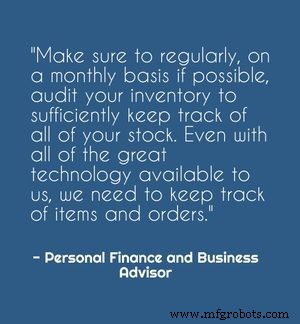
7. 일률적인 재고 관리 방법론이 반드시 있는 것은 아니지만 명확한 재고 관리 시스템 및 관련 정책을 개발하는 것은 모든 회사의 성공에 필수적입니다. “다양한 재고 관리 기술을 이해하려면 그것이 왜 중요한지 아는 것이 중요합니다.
- 첫째, 재고 관리를 잘못하면 운전자본이 불필요하게 증가할 수 있습니다. 초과 자금은 회사의 성장 이니셔티브 또는 연구 개발 노력을 촉진하는 데 유용하게 사용될 수 있었습니다.
- 둘째, 효과적인 재고 관리는 낮은 보관 비용으로 이어져 기업의 이익 증가로 이어진다. 저장 공간이 비쌉니다. 재고를 잘 관리하고 보관해야 하는 상품의 양을 줄일 수 있다면 필요한 공간이 줄어들어 창고 임대 비용이 낮아집니다.
- 셋째, 고객이 필요로 하는 제품을 가장 신속하게 공급하여 고객을 만족시킬 수 있습니다. 재고 관리가 부실하면 상품 가용성이 낮아지고 배송 시간이 길어집니다. 따라서 이러한 서비스 만족도 별을 얻으려면 인벤토리를 잘 관리해야 합니다.
- 넷째, 장기간 보관된 상품은 변질될 수 있습니다. 이는 사업 운영에 불필요한 간접비를 초래합니다. 따라서 적절한 재고 관리를 통해 이러한 비용을 크게 줄일 수 있습니다.
- 다섯째, 다양한 위치에 재고가 산재되어 있는 경우 수요와 공급을 기반으로 해당 재고를 관리할 수 있는 적절한 시스템이 필요합니다. 재고 관리 기술은 여러 재고를 관리하는 데 많은 도움이 됩니다.” – Laran Joseph, 재고 관리 기술 및 그 중요성 , Udemy 블로그; 트위터:@Udemy_Blog
8. 회사의 재고를 디지털 방식으로 관리할 수 있는 시스템을 평가하기 위한 주요 기능을 찾으십시오. "아니요, Excel을 사용하여 재고를 추적하는 것은 아닙니다. 귀하의 비즈니스에 적합한 재고 관리 솔루션을 말하는 것입니다. 모든 프로그램이 모든 사람에게 적합한 것은 아니므로 기능을 평가하는 데 시간을 할애하여 귀하의 요구 사항과 비즈니스 요구 사항을 모두 충족하는지 확인하십시오. 다음은 재고 관리 시스템 평가에 대한 몇 가지 유용한 정보입니다.
- 웹 기반: 웹 기반 솔루션을 갖는 것은 매우 중요합니다. 이러한 유형의 재고 관리 시스템은 종종 더 예산 친화적이고 더 많은 기능을 제공하며 일반적으로 구현하기 쉽습니다.
- 모바일 인벤토리: 이동 중에도 재고 관리 시스템을 사용할 수 있습니까? 웹 기반으로는 충분하지 않으므로 시스템이 iPad, iPhone, Android 또는 Windows Mobile과 호환되는지 확인하십시오.
- 바코드 통합: 바코드를 사용하면 데이터 입력 오류를 줄이고 재고 관리 프로세스의 속도를 높이는 동시에 일상적인 작업을 더 쉽게 수행할 수 있습니다.
- 측정 단위 변환: 구매 측정 단위가 재고 측정 단위와 다른 경우가 많다는 것을 이해하는 시스템을 사용하는 것이 중요합니다. Acme Supply에서 "케이스"별로 "위젯"을 구입할 수 있지만 동일한 "위젯"을 "각" 측정 단위로 직원에게 발행할 수 있습니다. 주문한 하나의 "케이스"에 50개의 "각각"이 있을 수 있는 시나리오를 종종 볼 수 있습니다. 재고 관리 시스템이 이 프로세스를 알고 이해하는 것이 중요합니다.
- 데이터 가져오기: 처음에 데이터를 가져오면 모든 공급품을 일일이 입력해야 하는 경우가 아니라면 몇 시간을 절약할 수 있습니다. 이 기능을 확인하십시오.
- 일괄 처리: 같은 작업을 반복해서 수행해야 하는 것을 좋아하는 사람은 아무도 없습니다. 선택한 시스템이 대량 트랜잭션 또는 대량 프로세스를 제공하여 큰 작업을 쉽게 수행할 수 있는 작업으로 전환하도록 합니다.
- 주기/물리적 개수: 결국 선반에 있는 공급품의 수량은 재고 관리 소프트웨어의 해당 품목 수량과 같지 않으므로 공급품의 주기 계산 또는 물리적 계산은 빠르고 쉬워야 합니다. 선택한 시스템이 이러한 기능을 빠르고 쉽게 수행할 수 있는 방법을 제공하는지 확인하십시오.
- 경고 및 알림: Low Par Alerts 및 기타 다양한 시스템 알림으로 자동으로 정보를 받아보세요. 아무도 놀라움을 좋아하지 않으며 자동 알림을 사용하면 다시는 놀라지 않을 것입니다." – 훌륭한 재고 관리를 위한 5가지 간단한 모범 사례 , 툴킷 그룹; 트위터:@TheToolkitGroup
재고 관리 기본사항
9. 재고 관리 시스템에는 몇 가지 핵심 요소가 포함되어야 합니다. “모든 부품 작업에는 다음과 같은 핵심 요소를 통합해야 하는 일종의 재고 관리 시스템이 필요합니다.
- 부품 재고가 소진되고 있음을 부품 담당자에게 미리 경고해야 합니다.
- 가격이 변경되는 경우 관리자가 문제를 조사하고 이러한 변경이 가격 인상인지 아니면 잘못된 청구로 인한 것인지 확인할 수 있도록 부품의 과거 구매 가격을 나열해야 합니다.
- 최상의 가격을 제공하는 공급업체를 나열해야 합니다.
- 관리자가 적절한 인벤토리 수준을 결정할 수 있도록 과거 사용률을 제공해야 합니다.
- 특히 역학에 의해 가능한 한 적은 양의 작성이 필요합니다." – John Dolce, 재고 관리 개선을 위한 15가지 팁 , 유틸리티 함대 전문가; 트위터:@UtilityFleetPro
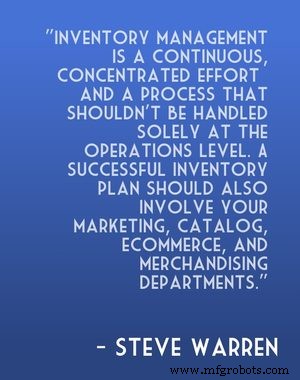
10. 먼저 계획을 세우고 실행하세요. “재고 관리는 지속적이고 집중적인 노력이며 운영 수준에서만 처리해서는 안 되는 프로세스입니다. 성공적인 재고 계획에는 마케팅, 카탈로그, 전자 상거래 및 상품화 부서도 포함되어야 합니다.
“마스터 프로모션 캘린더에 따라 재고를 관리함으로써 모두가 승리합니다. 구매 팀은 언제 얼마나 많은 제품을 구매해야 하는지, 귀하의 이행을 이해합니다. 제공업체는 추가 창고 공간을 준비해야 하는 시기를 알고 있으며 고객 센터 직원은 증가된 통화량을 예상할 수 있습니다.
“재고 달력에 전년도 판매 예측을 추가하여 수요의 계절적 급증에 더 잘 대비할 수 있습니다.” – Steve Warren, 효과적인 재고 관리를 위한 4가지 팁 , 다중 채널 판매자; 트위터:@mcmmerchant
11. 유지 관리 재고를 위한 중요한 예비 부품을 식별하고 항상 재고가 있는지 확인합니다. “중요한 예비 부품을 식별했습니까? 중요한 예비 부품 =긴 리드 타임(4-6주) X 생산 장비에 중요 X 높은 부품 비용. 이 부분은 생명 보험과 같습니다. 당신은 그것들이 절대 필요하지 않기를 바라지만 필요하다면 선반에 있는 것이 좋습니다." – 유지보수 재고 관리 개선 , 마샬 연구소; 트위터:@Marshall_Inst
12. 재고 수령이 주요 손실 지점이므로 배송을 면밀히 검토해야 합니다. “손실의 핵심은 재고를 받는 시점입니다. 카탈로그 선적에 대한 포장 전표를 면밀히 검토하는 것은 재고 관리를 위해 필요합니다. 또한 손상 클레임을 제기해야 하는 경우를 대비하여 운송 회사가 떠나기 전에 품목을 주의 깊게 검사하고 싶을 것입니다. 각 발송물은 면밀히 확인해야 하며 여기에는 제품 수를 세고 포장 명세서와 비교하는 것이 포함되어야 합니다. 차이를 기록해야 하며, 필요한 경우 배송을 담당하는 공급업체에 청구서를 제출해야 합니다." – 재고 관리 , 양배추; 트위터:@KabbageInc
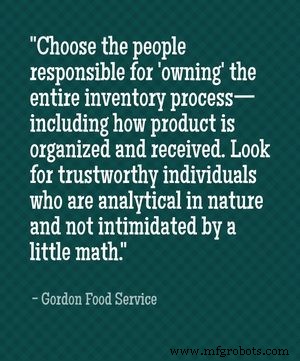
13. 조직의 재고 관리 프로세스를 담당하는 작업을 담당하는 올바른 재고 관리 팀을 지정합니다. “제품 구성 및 수령 방법을 포함하여 전체 재고 프로세스를 '소유'할 책임이 있는 사람을 선택하십시오. 천성적으로 분석적이며 약간의 수학에 겁먹지 않는 신뢰할 수 있는 사람을 찾으십시오.” – 작업 재고를 개선하고 음식물 쓰레기를 줄이기 위한 7가지 팁 , 고든 푸드 서비스; 트위터:@GFSDelivers
14. 유사 재고에는 필요한 경우 재고가 많은 위치를 제외하고 단일 저장 위치가 있어야 합니다. “유사한 재고를 단일 저장 위치로 모으십시오. 물리적 크기에 제한이 없는 한 동일한 부품이 여러 저장 영역에 있으면 안 됩니다. 이 경우 사용 가능한 수량을 최소로 유지하고 나머지는 쉽게 액세스할 수 있는 저장소의 일부가 아닌 위치(재고 과잉 위치)로 옮기십시오." – 실제 재고를 위한 창고 관리 팁 , riteSoft
15. 성공적인 재고 관리는 재고 비용과 재고 혜택 간의 적절한 균형을 찾는 것입니다. “성공적인 재고 관리에는 재고 비용과 재고 혜택의 균형을 맞추는 것이 포함됩니다. 많은 소기업 소유자는 보관, 보험 및 세금의 직접 비용뿐만 아니라 재고에 묶여 있는 비용을 포함하여 재고를 운반하는 실제 비용을 충분히 이해하지 못합니다. 너무 많은 재고를 유지하는 것과 충분하지 않은 것 사이의 미세한 선은 관리자의 유일한 관심사가 아닙니다. 기타:
- 다양한 종류의 주식을 유지하지만 빠르게 움직이는 주식을 너무 얇게 퍼뜨리지 않습니다.
- 재고 회전율을 높이지만 서비스 수준을 희생하지는 않습니다.
- 재고를 낮게 유지하되 서비스나 성능을 희생하지는 않습니다.
- 대량 구매를 통해 가격을 낮추지만 재고가 느리게 움직이는 것은 아닙니다. 그리고
- 적절한 재고를 보유하고 있지만 구식 품목에 걸리지는 않습니다.
“이러한 문제를 해결하는 데 성공한 정도는 다른 사람들보다 측정하기가 더 쉽습니다. 예를 들어, 재고 회전율을 계산하는 것은 관리 성과의 간단한 척도입니다. 이 값은 관리자가 목표를 설정하고 성과를 평가할 수 있는 대략적인 지침을 제공하지만 회전율은 재고 기능, 비즈니스 유형 및 비율 계산 방법(매출 또는 원가)에 따라 다릅니다. 판매된). 개별 산업의 평균 재고 회전율은 무역 협회에서 얻을 수 있습니다.” – 재고 관리 – 성공적인 재고 관리 , IPSCMI
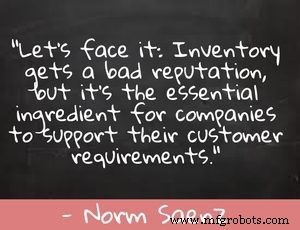
16. 인벤토리는 좋지 않은 평가를 받지만 거의 모든 산업에 걸쳐 비즈니스에 중요한 기능입니다. “직면하자. 재고는 평판이 좋지 않지만 기업이 고객 요구 사항을 지원하는 데 필수적인 요소입니다. 그들은 비즈니스를 유지하고 경쟁에서 우위를 점하기 위해 목표 고객이 필요로 하는 것을 가지고 있어야 합니다. 이 마지막 사실 때문에 많은 회사에서 선반에 매우 느리게 움직이거나 "죽은" 재고를 보관하고 있습니다.
“특정 회사의 재고 요구 사항은 고객 지원 요구 사항과 제조업체, 소매업체인 비즈니스 유형에 따라 다릅니다. , 도매 유통업체 또는 전자 상거래 회사. 이러한 일반 채널 범주 내에서도 제약/의약품, 식품, 의류, 일반 상품, 자동차, 전자, 건축 자재 및 기타 유형의 비즈니스의 재고 관리에는 상당한 차이가 있습니다.
“산업 및 서비스 수준이 재고 관행에 영향을 미치며, 공급망 및 공급업체 위험 및 불확실성과 같이 일부 회사에 초과 재고가 있는 일반적인 비즈니스 이유가 있습니다. 다양한 고객 수요 및 예측 정확도; 계절성 평준화; 리드 타임 문제; 가격 헤징; 충성도 높은 고객을 잃을 위험; 새로운 상품으로 판매를 주도하는 마케팅." – St. Onge의 전무 이사인 Norm Saenz; St. Onge의 수석 컨설턴트 Don Derewecki, 재고 관리 101:원칙을 다시 살펴볼 시간 , 물류 관리; 트위터:@LogisticsMgmt
17. 잘못된 재고 관리는 실제로 잘못된 유지 관리 또는 시설 관리 계획과 같은 훨씬 더 심각한 문제의 증상입니다. “다운타임:유지보수 및 신뢰성 업계의 모든 관리자가 두려워하는 단어입니다. 최상의 상황에서는 이익의 손실을 의미합니다. 최악의 경우 직장을 잃게 됨을 의미합니다. 다운타임을 유발하는 모든 문제를 완전히 피할 수 있는 것은 아니지만 그러한 문제를 아는 것이 도움이 됩니다. 이 블로그 게시물에서는 몇 가지 재고 관리 팁을 사용하여 가동 중지 시간을 없애는 확실한 방법을 검토할 것입니다.
“당신은 재고 관리가 상점에서 가동 중지 시간이 발생하는지 여부와 어떤 관련이 있는지 자문하고 있을 것입니다. , 나는 '많다'라고 대답하고 싶습니다. 잘못된 재고 관리는 훨씬 더 심각한 문제, 즉 잘못된 유지 관리 및/또는 시설 관리 계획의 증상입니다.
“모든 유지 관리 시스템의 핵심 단계 중 하나 당신의 책임하에 모든 장비를 알고 있습니다. 여기에는 각 장치의 연식, 공급업체가 누구인지, 공급업체 연락처 정보, 제품의 예상 수명, 제안된 유지 관리 절차 등을 포함하여 기계에 대한 정보도 포함됩니다. 이 중요한 정보를 바탕으로 장비가 계속 제대로 작동하도록 하는 건전한 유지 관리 계획을 수립하여 향후 가동 중지 시간 시나리오를 방지할 수 있습니다.” – Lisa Richards, 이 인벤토리 관리 팁으로 가동 중지 시간 방지 , 맵콘; 트위터:@MAPCONtech
18. 재고 관리는 그 중요성에도 불구하고 의료 서비스 제공자의 사무실과 같은 일부 환경에서는 여전히 구식으로 남아 있는 기능입니다. “많은 사무실에 재고 관리 시스템이 없기 때문에 막바지 프리미엄 가격으로 주문해야 하는 공급 부족을 경험합니다. 대부분의 관행은 디지털 스캐너 제어 시스템을 지원할 여유가 없거나 용량이 없습니다. 누락된 품목으로 인한 의사의 비효율적인 비용은 종종 소모품 비용보다 높습니다.
“다음 수동 시스템은 한 사람의 손에 재고 관리를 맡기는 동시에 사용하기 쉬운 간단하고 사용하기 쉬운 시스템입니다. 여전히 사무실의 모든 사람이 다른 사람에게 먼저 확인하지 않고도 필요할 때 소모품을 사용할 수 있습니다. 원하는 경우 각 검사실 또는 워크 스테이션을 비축하기 위한 하위 시스템도 만들 수 있습니다.
“시스템:
- 활용도 및 보관 공간에 따라 각 품목의 구매 주기(구매 빈도:주별, 월별, 분기별 등)를 결정합니다. 대부분의 사무실에서는 매주 또는 매월 공급품을 주문해야 합니다. 시험실이나 작업장을 위한 하위 시스템이 있는 경우 공급실에서 해당 영역을 재입고하는 데 주기가 적용됩니다.
- 각 구매 주기 동안 일반적으로 사용되는 각 항목의 양을 결정합니다.
- 처음에는 2번의 구매 주기 동안 각 항목을 충분히 구입하고 각 항목에 대해 2개의 번들을 만듭니다. 각 번들에는 한 구매 주기를 지속할 수 있도록 각 품목이 충분히 들어 있어야 합니다(유효 기간이 있는 품목 또는 독감 백신과 같은 계절 품목 제외). 각 묶음을 끈이나 고무줄로 감싸거나 각 묶음을 별도의 상자, 가방 또는 기타 용기에 넣습니다. 각 번들에 품목 이름, 공급업체, 단위당 최종 지불 가격, 구매 주기, 주문 금액 및 번들 품목 개수가 표시된 재사용 가능한 태그를 부착합니다.
- 봉투 재주문이라고 표시된 봉투를 눈에 띄게 걸어두십시오. 여기에 태그를 붙이세요.”라고 공급실에서 확인하세요.
- 용품이 필요할 때 직원이라면 누구나 번들에 액세스하여 태그를 제거하고 태그를 재주문 봉투에 넣을 수 있습니다. 액세스한 항목에 대해 전체 번들 하나와 부분 번들 하나가 남아 있어야 합니다.
- 재고 관리 담당자를 지정하여 재고 관리 태그와 라벨을 처리하고 구매 주기에 따라 새 소모품을 주문합니다. 점원이 온라인으로 물품을 주문하는 경우 온라인 공급업체에 번들 중 하나에 해당하는 재주문을 빠르고 쉽게 할 수 있는 기능이 있는지 확인하도록 하십시오.
- 물품이 도착하면 재고 관리 담당자만 배송을 열고 배송 인보이스를 원래 주문과 비교하여 정확성을 확인한 후 항목을 치워야 합니다.
- 상품을 다시 묶고 사용한 태그를 새 묶음에 다시 부착하여 주문 주기를 완료하십시오.
- 예를 들어 재고 교체와 같이 예기치 않게 항목에 대한 수요가 급증한 경우 이미 개봉되었을 수 있는 나머지 번들 뒤에 새 항목 번들을 배치합니다.
“필요에 따라 공급업체, 구매 주기, 주문량, 번들 크기를 언제든지 변경할 수 있습니다. 태그를 변경하여 변경 사항을 반영하기만 하면 됩니다.” – Keith Borglum, Q&A:소모품 비용 절감 및 재고 관리를 위한 팁 , 현대 의학 네트워크; 트위터:@메드이코노믹스
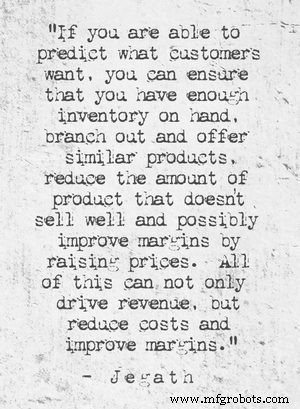
19. 중소기업은 견고한 재고 관리 시스템의 필요성을 무시해서는 안 됩니다. 방법과 소프트웨어 응용 프로그램을 고려할 때 가장 저렴하거나 무료 응용 프로그램을 선택하는 대신 비즈니스와 함께 성장할 수 있는 시스템을 선택하십시오. “당신은 당신의 사업이 작기 때문에 내 재고를 추적하는 데 많은 시간과 돈을 들일 필요가 없다고 생각할 수도 있습니다. 사업 규모가 크면 특별한 시스템을 구축할 필요 없이 스스로 지켜볼 수 있습니다.
“이런 사고방식이 문제가 될 수 있습니다. 재고 관리에는 단순히 재고를 계산하는 것 이상이 포함됩니다. 우수한 재고 관리 시스템에는 고객에게 배송되는 재고 추적도 포함됩니다. 적절한 재고 관리를 통해 어떤 제품이 잘 팔리고 있고 어떤 제품이 그렇지 않은지 알 수 있으므로 더 많이 비축해야 하고 어떤 품목을 이동하기 위해 판매를 고려해야 하는지 알 수 있습니다. 고객이 원하는 것을 예측할 수 있다면 충분한 재고를 보유하고 있는지 확인하고 유사한 제품을 분기하여 제공하고 잘 팔리지 않는 제품의 양을 줄이고 가격을 올려 마진을 개선할 수 있습니다. 이 모든 것이 수익을 창출할 뿐만 아니라 비용을 절감하고 마진을 개선할 수 있습니다.
“중소 기업 재고 관리 소프트웨어는 현금 관리에도 도움이 될 수 있습니다. 어떤 제품이 판매되는지 이해하고 이를 사용하여 적시에 구매 행동을 제어함으로써 비즈니스의 현금 전환 주기를 줄일 수 있습니다. 마찬가지로, 판매되지 않는 상품과 SKU를 제거함으로써 장기 현금 전환 상품에 묶여 있는 현금의 양을 줄일 수 있습니다. 이 모든 것이 중소기업에 중요합니다. 문제는 '재고관리 시스템이 필요한가'가 아니라 '얼마나 많은 돈과 시간을 투자해야 하는가'이다. 그런 다음 성장도 고려해야 합니다. 나중에 시스템을 전환하는 것은 매우 혼란스럽고 고통스러울 수 있습니다. 무료 재고 관리 소프트웨어는 소규모 비즈니스에 사용할 수 있지만 최선의 장기 전략은 아닐 수 있습니다. 당신과 함께 성장할 수 있는 서비스나 제품을 사는 것이 더 낫습니다.” – Jegath, 중소기업 소유자를 위한 팁:중소기업 재고 관리 소프트웨어를 통한 수익 창출 , 오르도로 블로그; 트위터:@ordoro
20. 유지 관리 조직의 경우 올바른 CMMS가 회사의 재고 관리 문제도 해결할 수 있다고 생각하는 함정에 빠지기 쉽습니다. 그러나 유지 관리 소프트웨어는 이미 효과적인 프로세스만 자동화하고 단순화합니다. “효과적인 재고 관리는 CMMS 구현의 ROI를 가속화하는 가장 좋은 방법 중 하나입니다. 그러나 재고 추적은 복잡하고 어려운 작업일 수 있습니다. 조직은 다양한 장비와 해당 장비를 적절하게 유지 관리하는 데 사용되는 예비 부품 및 도구를 추적해야 합니다.
“오랫동안 조직은 수동으로 재고 관리를 수행해야 했습니다. 다양한 수량과 다양한 특성을 지닌 재고 추적의 어려움은 수동 절차를 사용할 때 더욱 커집니다. 재고 관리 모듈은 더 나은 기록 유지 및 자동화된 보고를 통해 재고 관리를 단순화할 수 있습니다. 불행히도 재고 관리 모듈은 제대로 활용되지 않는 경우가 많습니다.
"많은 유지 관리 관리자는 재고 관리가 유지 관리 시스템의 자동 기능이라고 잘못 생각하지만 유지 관리 소프트웨어는 이미 효과적인 프로세스만 간소화하고 자동화할 수 있습니다." – Carol Owens, 유지보수 제어 소프트웨어로 재고 관리를 간소화하는 팁 , Business-Software.com; 트위터:@BiznessSoftware
21. 어떤 인벤토리 시스템, 방법 및 정책을 사용하든 회사의 중요한 데이터를 보호하기 위한 백업 계획을 항상 준비하세요. "당신의 모든 노력을 보호하십시오. 가장 첨단의 조직화된 재고 시스템이라도 백업 계획이 없으면 재앙적으로 탈선할 수 있습니다. 예를 들어, 최첨단 컴퓨터가 도난당하거나 화재로 인해 시설이 손상되어 서면 기록이 잿더미가 된 경우에는 어떻게 하시겠습니까? 시스템을 다른 곳(아마도 이동식 썸 드라이브)에 백업하여 이 재앙적인 시나리오를 피하십시오.” – Stephanie Howard, 관리자, 공급업체 및 재고 관리를 위한 팁 , Groovv; 트위터:@GroovvSolutions
Data Collection and Analysis Tips for Effective Inventory Control
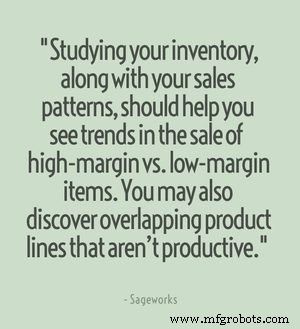
22. Find a way to evaluate what products are moving and what products are not. “One of the first ways to use your inventory information is to examine by product what is moving and what isn’t. Doing this on an ongoing basis will help identify products that may need to be discounted in order to replace them with faster selling items or in order to generate some cash. Studying your inventory, along with your sales patterns, should help you see trends in the sale of high-margin vs. low-margin items. You may also discover overlapping product lines that aren’t productive.” – Sageworks, 6 Tips to Improve Inventory Management , Funding Gates; Twitter:@FundingGates
23. Measurement is essential. You cannot control what you don’t measure. “Metrics are essential to a well-run supply chain. Metrics for their own sake, however, are worthless. The purpose of a metric is to drive change when the variable you are measuring trends in the wrong direction.
“A number of different metrics are useful for inventory management. Days supply by product and location based upon forecast is an excellent metric at the SKU level.
“When analyzing roll-up numbers for a product line, warehouse, or any other higher level, however, days supply is misleading because the lows cancel the highs and hide imbalances. At the higher level, inventory velocity is a much better measure of inventory health.
“No metric is useful, however, unless it is acted upon. Constant vigilance and early response to imbalances are the keys to ensuring best-practice inventory management.” – Jane B. Lee, 8 Common-Sense Rules for Inventory Management , Inbound Logistics; Twitter:@ILMagazine
24. Calculate your total costs. “It goes without saying that getting your inventory levels right is imperative, but what about the right quantities of your highest-performing brands and products? Maximizing sales of the goods with the most attractive margins can sometimes be tricky because of quantity discounts, special orders, and changes in wholesale prices (that you might not be aware of).
“It’s why looking carefully at total costs lets you know which products have the best margin, rather than just sell the fastest.
“Why calculate total costs?
- Focus on brands and vendors that yield the highest profits
- Find out which products perform the best by quantity margin
- Better manage discounts with a precise account of item cost” – Stephanie Braun, Fun Tips! 5 Ways To Improve Inventory Control Today , Lightspeed POS; Twitter:@LightspeedHQ
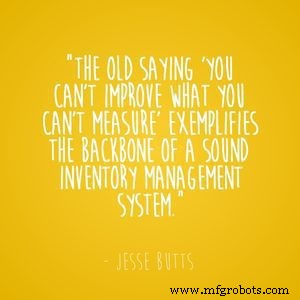
25. Track both inventory and sales data. “The old saying ‘you can’t improve what you can’t measure’ exemplifies the backbone of a sound inventory management system. If you haven’t yet started keeping thorough records, there’s no time like the present. As you create this records system, consider how it will accommodate the most vital inventory components:
- sales orders — documents comprising your customers’ purchase orders (requests for your product or service) in a format tailored for your business
- bills of materials — documents stating the inventory components (and hopefully labor) required to complete products or services
- work orders — if you’re involved in manufacturing, you’re probably familiar with these documents that include products’ details and their respective bills of materials
“You likely already have a system for recording transactions that includes sales orders (we hope). But most entrepreneurs haven’t taken the time to complete bills of materials, and for good reason:They are time-consuming. But, in the end, the benefits far outweigh the costs.
“Bills of materials are considerably easier to create for a retail storefront than for, say, a restaurant. In the food service industry, one sales order can relate to multiple bills of materials which, in turn, can require a few primary components and many others in small amounts. If you fall into the latter camp, determine the quantities of various invoice items needed for the appropriate bills of materials.” – Jesse Butts, How to Establish a Practical Inventory Management System , BizFilings; Twitter: @Toolkit
26. Check all stock inwards to account for errors in packing and other issues that may be missed if you simply assume the numbers match up. “The first focus should always be to check what actually gets delivered against what you have ordered from your supplier. It is so easy to assume that the numbers match up, but from talking to our customers we note that a good 1% to 2% of stock orders are incorrectly packed. If you just assume that you have the correct numbers of products when you add the inventory to your shelves you are liable to be short stocked when you receive a customer order. Another issue is that you might actually have more stock than you need and you won’t know when to reduce prices to move it or order more when you don’t need to.” – Stock Control and Inventory Management Tips , Cloud Fulfillment; Twitter:@CloudFulfillment
27. Centralize your data. “Regardless of how your inventory is set up physically, from a tracking perspective it should all be consolidated. This is especially the case if you have a web store and a physical one. Otherwise, you’ll appear disorganized and the process of buying could be confusing. As a bonus, being able to order online and either pick up or return in-store can seriously boost sales.” – 5 Tips for Streamlining Your Inventory Control Process , Blue Chip Inventory Service Int’l.; Twitter:@rodwalsh98
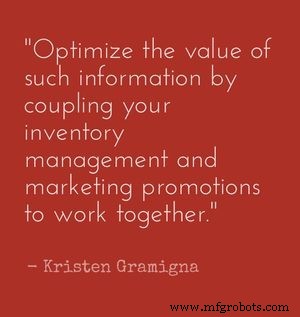
28. Inventory trends inform marketing plans. “Accurate inventory management incorporates what you know about customer and product demand from the past and present to (ideally) predict your best course of action in the future. A point of sale system can help quantify product level demand in tandem with recurring sales patterns, including those that fluctuate with some predictability (like seasonality, lifestyle occasions that impact your target audience and perhaps, local events).
“Optimize the value of such information by coupling your inventory management and marketing promotions to work together. For example, such insights can reveal potential opportunities to leverage quantity-based pricing vendors may offer, while at the same time empowering you to offset times of lower demand with promotions or ‘packaged’ deals that strategically drive sales, while moving the inventory that you acquired at a low cost.” – Kristen Gramigna, Keep Track of Your Precious Cargo:Tips for Inventory Management , Business.com; Twitter:@businessdotcom
29. Automate tracking with barcode labels and/or inventory management applications. “Another possible inventory management error is failure to track what you receive and what you sell. This can lead to losses, especially if you’re paying for products that are never showing up at your business, so some sort of tracking system is imperative. Automating the process with a barcode system and/or inventory management application is the smoothest way to handle this; note that the BizXpert app offers some useful inventory management features.
“Cycle counts are also recommended. Every day, pick a handful of items and count how many you have, comparing the number against what you have in your records. Pay special attention to big-selling and hot ticket items.” – Three Inventory Management Errors (And How to Avoid Them) , BizXpert; Twitter:@BizxpertApp
30. For many industries, including healthcare, inventory tends to follow the 80/20 rule. “Hospital inventory, like many things in life, often follows an 80/20 rule. 80% of the value of your inventory will be composed of just 20% of your actual product and most of those valuable items – whether they be assets, med-surg supplies, consignments or medication – fall into the departments of OR or Pharmacy. Plan your inventory efforts accordingly. Spend 80% of your time and energy optimizing the ordering and organization of the equipment, supplies and pharmaceutical products in these categories.” – Top 10 Tips for Hospital Inventory Management , Reliant Inventory Services
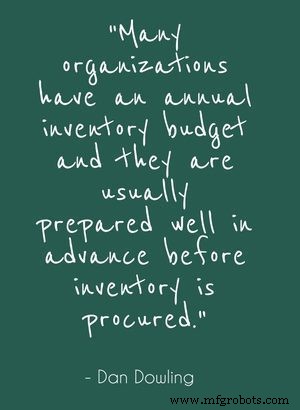
31. Inventory budgeting is a critical component of effective inventory control. “Many organizations have an annual inventory budget and they are usually prepared well in advance before inventory is procured. Budgets should include the total cost of ownership to keep inventory on hand during that year’s account period. This includes materials cost, fixed operational costs, carrying costs, logistics costs, redistribution costs and additional miscellaneous costs that contribute to the total costs of ownership.” – Dan Dowling, 6 Inventory Control Techniques for Stock Optimization , EazyStock Blog; Twitter:@EazyStock
32. When considering new inventory control software applications, be sure the cost is commensurate with functionality. “As you might expect, there are a lot of different types of inventory planning and control software out there. One of the biggest differences between many new solutions is whether they take advantage of cloud computing, or if they remain as locally installed software packages. For example, according to Inc.com , many providers of inventory control systems offer exclusively online, and full-service hybrid, versions of their software. The exclusively online versions are typically more limited in their functionality, while the full-service versions come with a higher price tag, but offer a greater number of services.” – Pat VanPutte, Inventory Control Systems Protect Your Bottom Line , NSA Computer Exchange Corp.; Twitter:@NSAComputerExch
Knowing Your Inventory and Your Company’s Needs
33. Don’t get caught with too much inventory. “Afraid of being caught short, it’s easy to spend too much on inventory, which can eat up working capital and erode profits. Warehousing isn’t free, of course, and inventory that sits on a shelf is subject to damage, depreciation, and even obsolescence. Old inventory can be very hard to move. Your options aren’t great,’ says Paul Huppertz, a logistics expert with The Progress Group, a supply chain consulting company based in Atlanta. ‘You may end up marking it down, selling to discounters, or shipping it to overseas liquidators.’
“To fix it: Start with some decent projections of how much supply you’ll need and when you’ll need it. The best gauge is what you’ve sold in the past. If you’ve sold 100 items per month for the past 12 months, chances are that you’ll need 100 this month. Then there’s seasonality:Do you usually see a fourth quarter spike with holiday sales? Or, if you’re in the home and garden business, do you see more activity in the spring selling season? ‘You can also identify and quantify less obvious patterns such as month-end spikes,’ says Huppertz.” – Lisa Girard, Five Steps to Painless Inventory Management , Entrepreneur; Twitter:@lisagjournalist
34. You should be able to break down your inventory into three basic categories:safety, replenishment, and excess or obsolete stock. “This breakdown makes it easier to make sound decisions about appropriate levels for each of these three areas. It helps determine the minimum safety stock needed to provide an insurance policy against supply chain problems either from manufacturing glitches or distribution uncertainties so that customers get what they ordered. It’s useful for pinpointing the amount of inventory required to replenish deliveries every two weeks. And it helps companies find ways to avoid a backlog of excess or obsolete inventory.” – Pratap Mukharji, Sam Israelit, Francois Faelli, Thierry Catfolis and Raymond Tsang, Ten ways to improve inventory management , Bain &Company; Twitter:@BainAlerts

35. Even with the most sophisticated automated data collection systems, a regular inventory audit is still valuable for keeping precise tabs on your inventory. “Make sure to regularly, on a monthly basis if possible, audit your inventory to sufficiently keep track of all of your stock. Even with all of the great technology available to us, we need to keep track of items and orders. This will help you to understand what is really selling and what is dead stock. Getting rid of dead stock is key to running an efficient warehouse operation. All you have to do is create a list of every product you have on your shelves – simple really.” – 5 Helpful Tips for Easy Inventory Control , Personal Finance and Business Advisor
36. Don’t be afraid to re-evaluate your company’s inventory control needs. “At what point do you realize that your approach to inventory management needs to change?
“Is it when you’re re-ordering an item you know you just ordered last week?
“Is it when you’re sending someone out for a 4-1/2-inch grinder and they’re gone over an hour?
“Or maybe it’s when you realize that you have hundreds of thousands of dollars—maybe millions—tied up in inventory, but you still don’t have exactly what you need the moment you need it.“If this sounds familiar, you’re not alone.“These are common practices in manufacturing environments where meeting production standards and schedules is the number-one priority, no matter what the cost. At some point, however, your finance department may recognize just how much time, money, resources and valuable shelf space is wasted on less–than–perfect inventory management practices. These days every company wants to streamline operations, improve productivity and gain that competitive edge. If you haven’t done it yet, re-evaluating your own inventory management system can help you accomplish some of these goals and significantly boost your bottom line.”
– 5 Tips for Getting Started With Vendor-Managed Inventory , Grainger; Twitter:@grainger
37. A CMMS is the backbone of effective inventory management and control for facilities. “The CMMS is the backbone of inventory management and control. Besides the typical modules —work orders, equipment records, material stores inventory, project management, standard reports, work-scheduling databases — the CMMS query system can yield summary inventory reports that supervisors and managers need.
“When each work-order status indicates the material is available, the work order is ready to go, and the maintenance planner can schedule it with the confidence that a lack of materials will not delay the job. Managers also can monitor the trend of work orders awaiting material.
“With real-time inventory control, the need for physical inventory decreases, especially if entries are accurate and complete. Out-of-stock trends can alert the stores supervisor to specific items that need expediting before they lead to equipment downtime. Managers also can monitor inventory-valuation trends efficiently.” – Thomas A. Westerkamp, CMMS:Backbone of Inventory Management and Control , FacilitiesNet; Twitter:@Maintenance_Mag
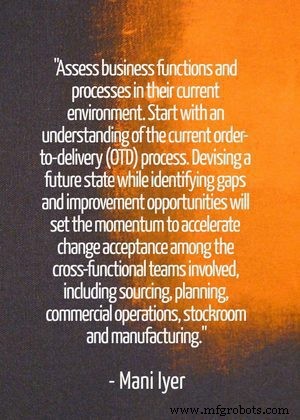
38. Conduct a business assessment. “Assess business functions and processes in their current environment. Start with an understanding of the current order-to-delivery (OTD) process. Devising a future state while identifying gaps and improvement opportunities will set the momentum to accelerate change acceptance among the cross-functional teams involved, including sourcing, planning, commercial operations, stockroom and manufacturing. Key activities in this stage should include:
- Study “As-Is” planning and execution process within the OTD process . Aim to have an unbiased assessment of current processes and practices. Start by interviewing a representative set of stakeholders who perform the same job within each function of the OTD process. Follow up with brainstorming sessions that involve key stakeholders from each function, which will help them understand their upstream and downstream process and address any issues arising out of lack of clarity of roles and responsibilities. These stakeholders should also voice their opinion on the desired “As-Is” state to establish a baseline against which improvements can be measured, and to effectively manage change through shared responsibility among their teams. Organizations should also consider conducting lean workouts among a cross-functional team of subject matter and Six Sigma process experts to understand redundant and non-value-added steps in the process due to multiple hand-offs between various functions within the OTD process.
- Summarize findings and gaps in data, process and practices. One of the ways to effectively capture the gaps in material planning and execution practices is through self-evaluation score sheets. A score sheet typically enlists the various planning and execution categories, and asks the functional owners to score according to the importance and effectiveness of each practice. Typical scoring criteria used is 1 (low), 5 (medium) and 9 (high) to clearly differentiate high impact gaps from lesser ones. For a more robust and objective view, third party service provider can also assist with benchmarking current processes against some of the best run companies in the industry.
- Devise “To-Be” planning and execution OTD process. Resource and system limitations may warrant a “To-Be Intermediate” state before moving to the ideal state. The objective is to outline a streamlined, robust and sustainable process that is aligned to the overall objective of optimizing inventory, customer service levels and variable costs. Organizations then begin to migrate to ideal state once resource and system limitations are addressed.
- Communicate to the whole group the identified improvement opportunities and goals . One of the biggest challenges faced during assessment is change resistance. Data-based inferences and identification of change catalysts is the key to driving fast adoption of more easily implemented improvements. By seeing immediate results, stakeholders will be better engaged to support additional and more sweeping process changes.” – Mani Iyer, Senior Business Manager, Genpact, Inventory Optimization:Five Steps to Improve Process Effectiveness , IndustryWeek; Twitter:@IndustryWeek
39. Understand your sales cycle and customer buying patterns to gain a better understanding of your customers. Effective inventory control is essential for customer service. “Inventory control is a customer service issue. Successful inventory management involves striking that balance between not having enough inventories on hand and having too much. Either you have the cost of excess inventory or the cost of a lost sale. It is painfully obvious which is lesser evil of the two.
“In order to conduct proper inventory control, you must have the ability to look at past sales and predict future demand. When forecasting your demand, you must learn from your past mistakes. Previous marketing promotions must be tracked closely to measure the impact of sales increases. Understanding your sales cycle and customer buying patterns will help you gain a greater understanding of your customers.” – James Ellis of Central Oregon Community College, Inventory Control:An Essential Element of Good Customer Service , Cascade Business News; Twitter:@cascadebusnews
40. Effective inventory control can reduce harmful consequences from mishaps such as the use of outdated or expired materials, such as those used in pharmacy preparations. “Large pharmacies, especially compounding pharmacies, often produce “stores of unwanted chemicals” used in the preparation of prescriptions. These chemicals are known as “bulk compounding chemicals,” and include substances such as tar, phenol and sulfur. Between the chemicals used to prepare prescriptions, pharmacies must also keep track of the compounds and drug products that are ingredients of the final medications. Given the many materials and types of chemicals used and produced, it is especially important for managers to use chemical inventory management systems to organize and keep track of the chemicals that enter and leave a facility.
“As mentioned above, the NECC used expired ingredients in their medications, which likely exposed a number of patients to adverse effects. Additionally, chemicals were not properly labeled. Using a chemical inventory management system prevents such oversight and in all likelihood, NECC lacked such a system. For compounding pharmacies and other such companies which would greatly benefit from tracking chemical supplies, let’s examine three ways a chemical inventory management system can help improve life for both employees and customers:
- Accurate data: The FDA has promised to clamp down on compounding pharmacies as a result of 2012’s incident; however, a random inspection should not be a reason to stress when facilities have a best practices chemical inventory management system in place. Many systems have gone completely digital by using barcode labeling and even providing remote inventory control. In this way, researchers and pharmacists can easily update inventory records, thus providing accurate and real-time data on the chemicals in stock.
- Expiration no more: Expired medications can be dangerous for patients; however, monitoring the expiration dates for both the chemicals used to produce prescription drugs as well as the chemical components of these drugs can be overwhelming. With a chemical inventory management system, managers can easily monitor expiration dates remotely, thus uncovering new opportunities for saving money by ordering less of a minimally used chemical, for example.
- Promote a safety culture: The most damning evidence against the NECC was its inability to create a culture of safety, one in which clear standards and practices are present and individuals are aware of the locations and proper disposal of items. The absence of such a culture perhaps helped contribute to the contamination of medications and it is no wonder that 14 former NECC executives and technicians were indicted on federal charges related to the outbreak. By implementing a chemical management system, leaders help ensure that employees understand the importance of safety and may act accordingly to protect the interests of all.
“What occurred at the NECC proved to be a fatal flaw for the company. Though the presence of a chemical management system may not have prevented the outbreak, if such a system were in place and used in conjunction with a digital notebook capable of recording the results of sterility tests, for example, the likelihood that such a mistake could occur would have been much less.” – Lilian N., Eliminating Harmful Substances Before They Reach Patients with Chemical Inventory Management , Biovia; Twitter:@3dsBIOVIA

41. If your company must maintain inventory for equipment repairs, consider parts that can be used in a number of applications. “If you store clamps and couplings that can be used in a number of applications, you won’t need to keep as many in stock and space is reduced. Full transition couplings that fit pipes of varying types and sizes within your water or wastewater infrastructure save space and help you stay prepared for multiple scenarios. There are also products that have the versatility to either join or repair pipes.” – David Wheat, Simple Steps For Inventory Control , Municipal Sewer &Water; Twitter:@MSWmagazine
Creating Effective Inventory Control Policies
42. Creating clear policies and processes allows your company’s inventory control function to run like a well-oiled machine. “It can be an uphill battle keeping your company’s inventory effectively organized and managed. There are some subtle nuances that are easy to overlook but should ultimately not be ignored. Compass Technologies, which provides retail point-of-sale, wholesale and distribution services to its customers, offers some helpful advice for inventory and organization management.
- Limit access to inventory. Only those who need to have their hands on inventory and inventory data should be allowed access.
- Establish well defined, user-friendly storage and receipt management policies. Check lists and data tables.
- Create an inventory system that utilizes multiple locations to replenish inventory from multiple sites – minimize distribution costs.
- Clearly map and label inventory areas, easy to read and understand with item descriptions.
- Track annual and seasonal regular inventory demand analysis. Use competitive data for start-up companies.
- Track and document inventory processes, including reviews.
- Inventory data base- GP and Add-On solutions.
- Use inventory alerts to make management aware of stock limits.
- Manage paperwork, purchase orders, receipts and inventory counts with GP for reporting.
- Utilize software add-on solutions to further manage the inventory process.” – Hillary Horning, Compass Technologies, 10 Tips for Smooth and Accurate Inventory Organization and Management , ERPSoftware Blog; Twitter:@erpsoftwareblog
43. All items should have an SKU, barcode, and product specifications. “Similar to a driver’s license, every product needs to have a unique ID number known as a SKU (Stock Keeping Unit). A SKU is vital for internal use as there will be instances where a particular product needs to be found quickly and having an SKU will make it easy to find. Additionally, having a SKU is imperative because another company could have a product named “Black Pants” exactly like and resellers are dealing with multiple vendors, thus creating a need to differentiate between similar products.
“Second, when working with other companies such as resellers whether it be an independent e-commerce store, a brick and mortar store or a big-box chain, a universal barcode/UPC number will be expected. A UPC number is another form of a SKU, but instead it comes in the form of a barcode which can be scanned and identified through a live database powered by GS1. Be cautious not to purchase UPC numbers from anywhere but GS1 or a valid reseller. The whole point of a barcode is to be scanned and looked up via a database, so having a barcode that brings up a different product from another company causes a lot of confusion and could potentially lose customers.
“Finally, it is always good to have a system for listing all your products specifications. Those specifications should have at least the following:
- Product Name
- SKU Number
- UPC Number
- Description
- Color
- Size
- Price
- Weight
- Dimensions (depending on product)” – Raad Mobrem, 6 Tips for Inventory Management , Small Biz Resources; Twitter:@SmallBiz_Help

44. Dedicated inventory control managers or other administrators should be tasked with handling the administrative tasks associated with inventory control, and these roles should be separate from accounting or finance departments. “There are many administrative tasks associated with stock control. Depending on the size and complexity of your business, they may be done as part of an administrator’s duties, or by a dedicated stock controller.
“For security reasons, it’s good practice to have different staff responsible for finance and stock.
“Typical paperwork to be processed includes:
- delivery and supplier notes for incoming goods
- purchase orders, receipts and credit notes
- returns notes
- requisitions and issue notes for outgoing goods
“Stock can tie up a large slice of your business capital, so accurate information about stock levels and values is essential for your company’s accounting.
“Figures should be checked systematically, either through a regular audit of stock – stocktaking – or an ongoing program of checking stock – rolling inventory.
“If the figures don’t add up, you need to investigate as there could be stock security problems or a failure in the system.
“Health and safety aspects of stock control are related to the nature of the stock itself. Issues such as where and how items are stored, how they are moved and who moves them might be significant – depending on what they are.
“You might have hazardous materials on your premises, goods that deteriorate with time or items that are very heavy or awkward to move.” – Stock Control and Inventory , Info Entrepreneurs; Twitter:@chambremontreal
45. Make inventory accuracy a higher priority than order fulfillment. “Raising the priority of accurate inventory is perhaps the most important, yet most difficult, step in inventory accuracy. Many inventory problems arise from pushing a transaction through the system with the intent of going back and fixing the numbers later. In the rush of other emergencies, however, we often forget to go back and correct the numbers in the system. This leads to missed production entries, negative lines of inventory, and a whole mess of other problems. Only by putting systems in place that will prevent an employee from moving forward without the necessary system transaction can you effectively keep accurate records of inventory.
“One example of success that my team recently implemented was changing our accounting system so that it will not process any shipment that contains more inventory than we have on hand. For example, if we’re trying to ship 15 of an item, but our system says we only have 5 in stock, then an alert will pop up and force us to fix the problem before moving forward. This helps us address problems before the product goes out the door. By forcing us to address missed production entries before the product leaves, our modified system helped us eliminate most of our major inventory issues.” – Alex Fuller, 10 Tips to Make Physical Inventory Counts Less Painful and More Accurate , Supply Chain Cowboy
46. Inventory management software is a valuable tool and superior to outdated spreadsheet methods. “Using the right tools for the job is a must. Many companies choose spreadsheets for inventory management software because it seems like the familiar and easy thing to do. Unfortunately, spreadsheets come with built-in risks:it’s far too easy to lose changes or accidentally delete a spreadsheet file. It’s also difficult for multiple people to synchronize their spreadsheets, which further increases the risk for error. Find a low-cost but effective software for managing your inventory, such as Peachtree or QuickBooks. Most organizations overlook these options for inventory management because they’re best known for their accounting features. However, they offer invaluable inventory management software features and a central database to streamline inventory operations, increase accuracy, and minimize the possibility of error.” – 5 Supply Chain Management Inventory Tips , Women’s Distributor Services (WDS); Twitter:@WDSJennifer
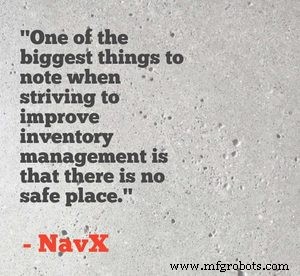
47. Optimizing inventory control requires continuous improvement. “One of the biggest things to note when striving to improve inventory management is that there is no safe place. Maintaining the right balance of inventory levels, properly organizing your warehouse for maximal efficiency, and ensuring that you have complete insight into your processes will go a long way in helping you improve effective inventory management however when you think you’ve succeeded, the worst thing you can do it sit back and relax. Taking a critical approach to operations, including inventory management, is fundamental to maintaining your competitive edge. Be sure to monitor costs as well as performance; if you see that inventory carrying costs are rising, maybe your forecasting isn’t as accurate as it could bet. If customer satisfaction falls, take a look at your order history. If you’re sending out incomplete orders, or items aren’t being sent to customers in a timely manner, dig a little bit deeper. By building the philosophy of continuous improvement into your organization and your inventory management strategy, you will be able to achieve greater efficiency and profitability.” – 3 Tips for Improved Inventory Management , NavX; Twitter:@NAVX_software
48. Cycle counts can be a useful alternative to stock-wide physical inventory counts. “Cycle-counts have become SOP with a growing number of mid-sized firms since more business software packages now provide this functionality. The benefits of employing a cycle-count regimen over periodic stock-wide physical counts are great. Cycle-counts are less disruptive to operations, offer greater specificity in determining what items should be counted and generally force greater discipline into the organization’s inventory management.” – Tips for Improved Inventory Control:Part 5/8 , TBS Automation Systems
49. Take steps to maximize both your profit and resources by involving team members and distributors in key processes. “There are many best practices that any Supply Chain Manager should follow, but a few of the strategies that tend to ensure maximizing not only profits but resources needed include:
- Working with your team and distributor to maximize service and savings; everyone should be clear on the expectations of the strategy you have defined.
- Once strategy is implemented continue consistent monitoring of purchasing behaviors. Many times a focus on efficiencies over time begins to become complacent resulting in overpayment for suppliers and an increase in overall supply chain costs.
- Understand the difference between “cost” and “price.” Many times, the manufacturer costs revealed for the savings analysis do not include the distributor mark-up, holding costs, or the freight costs. Also remember to keep in mind that being able to secure products through a manufacturer directly needs to apply to all of their products in that category, not just one of the more highly utilized items.
- Establish your ability to purchase in the lowest unit of measure. This will ensure that you are not over-ordering on products you may not use frequently or on any consistent basis.
- Be sure of what your GPO compliance requirements are. [This] includes not only volume in units, but may also include dollar-volume commitments. It is important to remember that reducing your pricing on actual supplies may interfere or require an amendment to your GPO agreement in order to maintain compliance. Many times hospitals secure agreements that include commitment to process a set dollar volume through the GPO base agreements that must be fulfilled to maximize the benefits of the entire portfolio.” – Lori Pilla, Vice President, Amerinet Clinical Advantage and Supply Chain Optimization, Amerinet Inc., St. Louis, as quoted in More inventory management best practice tips , HPN Online; Twitter:@HPN_Online, @AmerinetInc
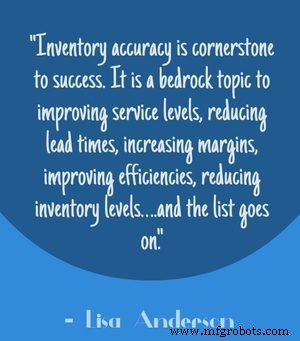
50. Follow best practices for conducting physical inventory counts. “Inventory accuracy is cornerstone to success. It is a bedrock topic to improving service levels, reducing lead times, increasing margins, improving efficiencies, reducing inventory levels….and the list goes on. Although I recommend implementing cycle counting programs as a way to replace physical inventories, there are times when a physical inventory is a must. Thus, it is worth thinking about a few tips to successfully complete a physical inventory.
- Prepare, prepare, and prepare: 80% of your success is in preparation. Organize the warehouse, clearly mark areas, label exceptions, complete and review system transactions, etc.
- Stop/isolate movement: When you begin your physical count, stop all physical and system movements and transactions. This is a critical foundation – similar to building a house, if you start adding windows prior to finishing the walls, the house might begin to fall apart.
- People and communication: Make sure the right people are in the right jobs for their skill sets. And, communicate, communicate, communicate. Make sure everyone has clear instructions, understands how to get questions answered, etc.
- Manage the control desk: This is the term I’ll use for the team organizing and controlling the process – the Grand Central Station hub. Typically, this person/team keeps track of count sheets, makes sure everything “adds up”, answers questions and keeps the process moving.
- Metrics/tracking progress: Putting the key metrics and vehicles in place to track progress is cornerstone to success. By reviewing these metrics, the leader can review progress, make adjustments as required and keep the process on track. Metrics also provide for a way to measure success.” – Lisa Anderson, Tips for Physical Inventory Success , LMA Consulting Group; Twitter:@LisaAndersonLMA
51. Give your employees tools that make them more efficient, which leads to more accurate inventory control. “Other than employees, inventory is a company’s largest asset. Reducing inventory levels and increasing inventory turns can lead to immediate savings on a company’s bottom line. Also, it’s important to consider the “landed cost” of your products. While your supplier may have a book price with bulk discounts, consider how much the product actually will cost you from the time you purchase it to the time it lands at your warehouse dock. Cargo fees, customs, and transportation add up quickly and can shrink profit margins. To navigate these challenges, consider these five tips:
- Reduce compounded safety stock: Most companies keep an extra cushion of inventory to account for unexpected demand. The problem is that when every vendor in a supply chain (raw material supplier, manufacturer, retailer) maintains that extra 5 percent to 10 percent of cushion, it adds up to unnecessary costs for each organization. The key is to communicate closely and often with your suppliers and trading partners to prevent overproduction and increased carrying cost for them. Find ways to collaborate and eliminate excess safety stock.
- Give employees tools to make them more efficient: In tough times, high-quality employees that you strive to retain can get burned out. They likely will absorb the duties of their more expendable colleagues. One way to keep them happier and more productive is to give them the technology tools that will make their jobs easier. Technology that automates tasks or offers predictive models about supply and demand will help reduce the manual aspects of their jobs, so they can focus on driving sales or broader strategies to help grow your business.
- Optimize your inventory: Simply said, you need to get rid of the inventory you don’t sell and get more of the inventory you do. The concept sounds straightforward but many small and midsize businesses have the wrong mix of inventory. While it may be painful to liquidate the inventory you spent precious resources to secure, having it take up warehouse space and require your team to manage it will cost you more in the long run. That space and mindshare could be spent on inventory that is hot and will turn over quicker, and that means more profit in your pocket. Take the short-term hit and implement a system that sheds products that don’t sell and invest in those that do.
- Focus on banner products: Growing up, there were just three kinds of soap at the grocery store:Dove, Dial, and Lava. Now a visit to the soap aisle could add another 15 minutes to a shopping trip because there are just too many choices. By adding variations to your product line versus introducing completely new and different products, you actually cannibalize your own sales and risk confusing customers to the point of apathy. Concentrate on your best products and create customer brand loyalty, which will create “customers for life” versus fickle ones.
- Manage to the future: Understand that in today’s economic climate, cash is king. If you are sitting in a good position, make cutbacks to your spending but invest in tools and people that will help you in the long run to grow your business and drive greater efficiency. With layoffs and companies eager to keep sales high, you can secure some top quality talent and excellent deals on the technology tools you need.
“In times like these, it is key to stay positive but manage realistically, cutting short-term costs that you can afford to cut. The important thing is to understand which assets are mission-critical and which ones need to be shed. Properly managing the No. 1 or No. 2 asset of your company will allow you to cut expenses and increase sales.” – Bill Harrison, Top Five Tips to Rescue Your Business with Inventory Management , AllBusiness; Twitter:@AllBusiness_com
Asset Tracking Solutions from Camcode:
- 재고 관리
- 재고 관리
- 맞춤형 호일 라벨
- 창고 표지판
- 통로 표지판
- Stainless Steel Tags
- 바닥 라벨
- 보안 레이블
- 마그네틱 라벨



















